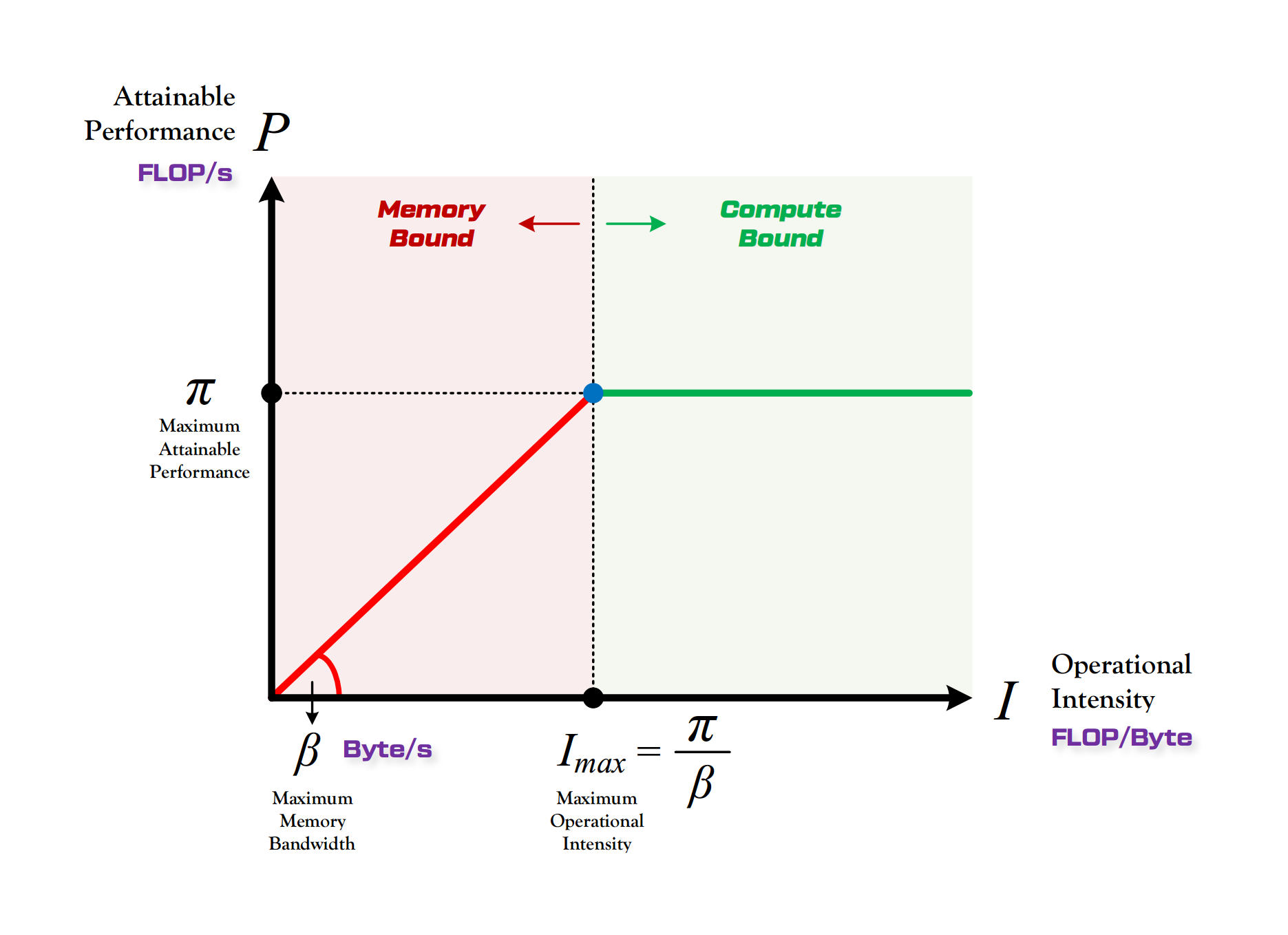1. Estimating Total FLOPs
We only consider the FLOPs of Transformer layers, excluding the embedding layer and the output layer.
Attention:
- Each projection for Q, K and V is matmul of input
(B, S, H)and weight(H, H), yielding(B, S, H):
$$ \text{FLOPs} = 3 \times (2 \times B \times S \times H \times H) = 6 \times B \times S \times H^2 $$ - $S = QK^T$, matmul of $Q$
(B, S, H)and $K^T$(B, H, S), yielding(B, S, S):
$$ \text{FLOPs} = 2 \times B \times S \times S \times H = 2 \times B \times S^2 \times H $$ - $L = S \cdot V$, matmul of $S$
(B, S, S)and $V$(B, S, H), yielding(B, S, H):
$$ \text{FLOPs} = 2 \times B \times S \times H \times S $$ - $O = L \cdot W_O$, matmul of $L$
(B, S, H)and $W_O$(H, H), yielding(B, S, H):
$$ \text{FLOPs} = 2 \times B \times S \times H^2 $$ - Total attention FLOPs per Transformer layer: $$ \text{FLOPs} = 8 \times B \times S \times H^2 + 4 \times B \times S^2 \times H $$
- Each projection for Q, K and V is matmul of input
Feed-Forward Networek
Typically 2 linear layers, one mapping(B, S, H)to(B, S, 4H)and the other mapping(B, S, 4H)to(B, S, H):Total FFN FLOPs per Transformer layer:
$$ \begin{align*} \text{FLOPs} &= 2 \times B \times S \times H \times (4 \times H) + 2 \times B \times S \times (4 \times H) \times H \\ &= 16 \times B \times S \times H^2 \end{align*} $$
Total FLOPs: $N$ Layers of Transformer
Each Transformer layer consists of an attention mechanism and a feed-forward networkWhen prefilling, the total FLOPs is:
$$ \text{FLOPs}_\text{total} = N (24 B S H^2 + 4 B S^2 H) $$When decoding, suppose the input is of shape
$$ \text{FLOPs}_\text{total} = N (24 B S_i H^2 + 4 B S_i S_c H) $$(B, Si, H)and KV cache is of shape(B, Sc, H), the total FLOPs is:
2. Estimating Total Bytes Transfered
In FP16, each parameter or activation element is 2 bytes.
Data transferred includes loading model weights and handling activations.
Suppose we have a $Z$-B-fp16 model and $N$ Transformer layers, each with input size (B, S, H).
Model Weights
$$ \text{Bytes}_\text{weights} = Z \times 10^9 \times 2 ~ \text{Bytes} = 2 \times Z ~ \text{GBytes} $$
A $Z$-B-fp16 model has $Z \times 10^9$fp16parameters, each 2 bytes:In an optimized GPU inference, weights are typically loaded into high-bandwidth memory (HBM) once and reused, so we assume $2Z$ GB is read once per forward pass.
Activations
- For each Transfomer layer, input and output activations are of shape
(B, S, H), and each element is 2 bytes infp16: $$ \text{Bytes}_\text{act-layer} = B \times S \times H \times 2 ~ \text{Bytes} $$ - For $N$ layers, activations are computed sequentially. Since each layer’s output becomes the next layer’s input (read once, written once):
$$ \begin{align*} \text{Bytes}_\text{act-total} &= 2 \times N \times \text{Bytes}_\text{act-layer} ~ \text{Bytes} \\ &= 4 \times N \times B \times S \times H ~ \text{Bytes} \end{align*} $$
- For each Transfomer layer, input and output activations are of shape
KV Caches
$$ \text{Bytes}_\text{KV} = N \times (B \times S_c \times H + 2 \times B \times S_i \times H) \times 2 ~ \text{Bytes} $$
When decoding, each Transformer layer would load cached K and V both of shape(B, Sc, H). After decoding, the new K and V of shape(B, Si, H)are computed and cached for the next layer. So the bytes transfered for one forward pass is:Total Data Transferred
When prefilling, the total bytes transferred is:
$$ \begin{align*} \text{Bytes}_\text{total} &= \text{Bytes}_\text{weights} + \text{Bytes}_\text{act-total} \\ &= 2 Z \text{e}^9 + 4 N B S H ~ \text{Bytes} \end{align*} $$When decoding, suppose cached sequence length is $S_c$ and the input sequence length is $S_i$, the total bytes transferred is:
$$ \begin{align*} \text{Bytes}_\text{total} &= \text{Bytes}_\text{weights} + \text{Bytes}_\text{act-total} + \text{Bytes}_\text{KV} \\ &= 2 Z \text{e}^{9} + 8 N B S_i H + 2 N B S_c H ~ \text{Bytes} \end{align*} $$
3. Arithmetic Intensity
When prefilling, there is no cached K and V, so the arithmetic intensity is:
$$ \begin{align*} \text{Arithmetic Intensity} &= \text{FLOPs}_\text{total} / \text{Bytes}_\text{total} \\ &= \frac{N (24 B S H^2 + 4 B S^2 H)}{2 Z 10^9 + 4 N B S H} \end{align*} $$When decoding, suppose cached sequence length is $S_c$ and the input sequence length is $S_i$ , then the arithmetic intensity is:
$$ \begin{align*} \text{Arithmetic Intensity} &= \text{FLOPs}_\text{total} / \text{Bytes}_\text{total} \\ &= \frac{N (24 B S_i H^2 + 4 B S_i S_c H)}{2 Z 10^9 + 8 N B S_i H + 2 N B S_c H} \end{align*} $$4. Roofline Model

A100-80GB has the following hardware `specifications:
- Peak FLOPs ($\pi$): $312 \times 10^{12}$ FLOPs/s
- Memory Bandwidth ($\beta$): $2039 \times 10^9$ B/s
- Machine Balance ($I_{max}$): $312 \times 10^{12} / (2039 \times 10^9) \approx 153$ FLOPs/Byte
Here are two examples of arithmetic intensity estimation:
5. Discussion: Tensor Parallelism
If the model is split across multiple GPUs using TP, the hidden size H and the model weight is divided by the number of GPUs.